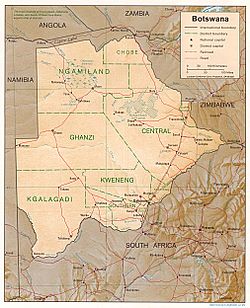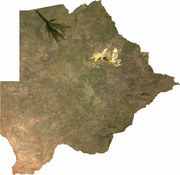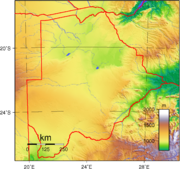
Geography of Botswana
About this schools Wikipedia selection
This selection is made for schools by a children's charity read more. Sponsoring children helps children in the developing world to learn too.
| Geography of Botswana | |
|---|---|
 |
|
| Continent | Africa |
| Region | Southern Africa |
| Coordinates | 22°00′S 24°00′E |
| Area | Ranked 47th 581,730 km2 (224,610 sq mi) 97.42% land 2.58% water |
| Borders | Total land borders: 4,013 km (2,494 mi) Namibia: 1,360 km (850 mi) South Africa: 1,840 km (1,140 mi) Zimbabwe: 813 km (505 mi) |
| Highest point | Tsodilo Hills 1,489 m (4,885 ft) |
| Lowest point | Junction of the Limpopo and Shashe Rivers 513 m (1,683 ft) |
Botswana is a landlocked country located in Southern Africa, north of South Africa. Botswana occupies an area of 600,370 square kilometres, of which 585,000km² are land. Botswana has land boundaries of combined length 4,013 kilometres, of which the constituent boundaries are shared with Namibia, for 1,360 km; South Africa 1,840 km; Zimbabwe, 813 km and Zambia, less than 1 km. Much of the population of Botswana is concentrated in the eastern part of the country.
Physical geography
Climate
Botswana is semi-arid, due to the short rain season. However, the relatively high altitude of the country and its continental situation gives it a subtropical climate. The country is remote from moisture-laden air flows for most of the year. The dry season lasts from April to October in the south and to November in the north where, however, rainfall totals are higher. The south of the country is most exposed to cold winds during the winter period (early May to late August) when average temperatures are around 14 °C (57.2 °F). The whole country has hot summers with average temperatures around 26 °C (78.8 °F). Sunshine totals are high all year round although winter is the sunniest period. The whole country is windy and dusty during the dry season.
Orography
The land is predominantly flat to gently undulating tableland, although there is some hilly country, where mining is carried out. The Kalahari Desert is in the central and the southwest. The Okavango Delta, the world's largest inland delta, is in the northwest and the Makgadikgadi Pans, a large salt pan lies in the north-central area. The Makgadikgadi has been established as an early habitation area for primitive man; This large seasonal wetland is composed of several large component pans, the largest being Nwetwe Pan, Sua Pan and Nxai Pan. Botswana's lowest elevation point is at the junction of the Limpopo and Shashe Rivers, at a height of 513 m. The highest point is Monalanong Hill, at 1,494 m. The country is divided into four drainage regions, which are sometimes indistinct due to the arid nature of the climate:
- the Chobe River on the border with the Caprivi Strip of Namibia together with a small adjacent swampy area is part of the Zambezi basin;
- most of the north and central region of the country is part of the Okavango inland drainage basin;
- the easternmost part of the country falls into the Limpopo drainage basin;
- the southern and southwestern regions, which are the driest of all, are drained by the Molopo river along the South African border and the Nossob river through the Kalahari Gemsbok National Park, and are technically part of the basin of the Orange river. None of these rivers normally flows as far as the Orange, however. (The last recorded confluence was in the 1880s.)
Except for the Chobe, Okavango, Boteti and Limpopo rivers, most of Botswana's rivers cease to flow during the dry and early rainy seasons.
Natural hazards
Botswana is affected by periodic droughts, and seasonal August winds blow from the west, carrying sand and dust, which can obscure visibility.
Environment
Current environmental issues in Botswana are overgrazing, desertification and the existence of only limited fresh water resources.
Research from the University of Botswana has found that the common practice of overstocking cattle to cope with drought losses actually depletes scarce biomass, making ecosystems more vulnerable. The study of the Kgatleng district predicts that by 2050 the cycle of mild drought is likely to become shorter —18 months instead of two years—due to climate change.
International agreements
Botswana is a party to the following international agreements: Diamond Industry, Biodiversity, Climate Change, Desertification, Endangered Species, Hazardous Wastes, Law of the Sea, Nuclear Test Ban, Ozone Layer Protection and Wetlands.


